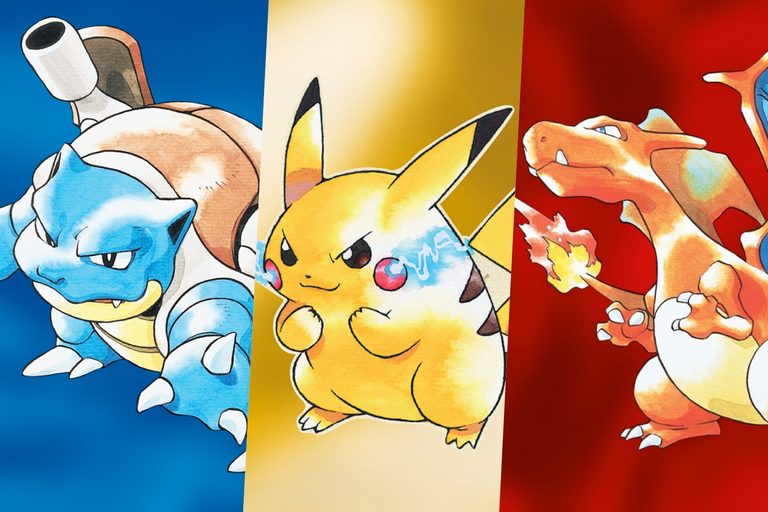When people think about video games that defined childhood memories, Pokémon Red, Blue, and Yellow often rise to the top of the list. Released during the late 1990s, these titles didn’t just mark the start of a new gaming franchise—they created a global cultural wave that continues to this day. They were more than just handheld games; they became a shared experience across playgrounds, bus rides, and family living rooms.
Even decades later, revisiting the original Pokémon adventures in the Kanto region brings back a sense of wonder and nostalgia. To understand why these games hold such a timeless charm, it’s worth taking a deeper look into their history, gameplay, and enduring legacy.
The Origins of Pokémon Red and Blue
The Pokémon franchise began in Japan with the release of Pokémon Red and Green in 1996 for the Game Boy. Developed by Game Freak and published by Nintendo, the idea was the brainchild of Satoshi Tajiri, who wanted to capture the feeling of collecting creatures he experienced as a child. The games were modest in scope but ambitious in vision, aiming to create a living world where players could collect, train, and battle creatures with unique abilities.
When the series was brought to the West in 1998, Pokémon Red and Blue became the chosen versions. The localization not only translated the language but also adjusted elements of the game to appeal to international audiences. Despite being simple by today’s gaming standards, their concept was groundbreaking at the time, offering a blend of adventure, strategy, and exploration never seen before in handheld gaming.
Pokémon Yellow: Pikachu Takes the Spotlight
In 1998, following the massive success of the Pokémon anime, Nintendo released Pokémon Yellow: Special Pikachu Edition. Unlike Red and Blue, where players could choose between three starter Pokémon, Yellow began with Pikachu as the sole companion—mirroring the relationship between Ash Ketchum and Pikachu in the TV show.
This version added subtle but meaningful changes. Pikachu followed the player around on-screen, reacting to different situations, something revolutionary for a Game Boy title at the time. The game also featured updated sprites and closer ties to the anime, including appearances from Jessie and James of Team Rocket. These adjustments made Yellow more than just a re-release; it became an enhanced experience that appealed to fans who were falling in love with both the games and the animated series simultaneously.
The Gameplay Experience
At the heart of Pokémon Red, Blue, and Yellow was the simple yet addictive gameplay loop: catching, training, and battling Pokémon. Players explored the Kanto region, traveling through towns, caves, and forests, all while collecting creatures to fill their Pokédex.
The battles were turn-based, requiring players to think strategically about type matchups. Choosing the right move against an opponent could make the difference between victory and defeat. Grass, Fire, and Water types created a rock-paper-scissors dynamic, while Psychic Pokémon dominated the early game balance.
Progress was marked by defeating Gym Leaders, each specializing in a specific type of Pokémon. The ultimate challenge came with the Elite Four and the battle against rival trainers. Legendary creatures like Articuno, Zapdos, Moltres, and especially Mewtwo gave players unforgettable moments of discovery and challenge.

Multiplayer and Trading
One of the most innovative aspects of the original games was the use of the Game Link Cable. For the first time, handheld players could connect their devices to trade Pokémon or battle against one another.
This feature wasn’t just a gimmick—it was essential. Certain Pokémon were exclusive to Red, others to Blue, and some required trading to evolve, such as Machoke becoming Machamp or Kadabra evolving into Alakazam. This encouraged social interaction and created a sense of community around the games. Children and teenagers suddenly had a reason to bring their Game Boys to school, swapping Pokémon in the same way they traded cards or stickers.
This multiplayer foundation laid the groundwork for what would become one of the defining aspects of the franchise: a focus on connection, cooperation, and friendly rivalry.
Cultural Impact
The release of Pokémon Red, Blue, and Yellow coincided with a massive wave of popularity for the Pokémon brand. The games directly fueled the Pokémon anime, the trading card game, toys, and a wide range of merchandise. This explosion of interest became known as “Pokémania,” dominating schoolyards and popular culture in the late 1990s and early 2000s.
Unlike many gaming fads, however, Pokémon wasn’t just a passing trend. It established itself as a franchise with staying power, creating new generations of players with every release. The original trio of games was the foundation of a global brand that now spans video games, television, movies, trading cards, and more.
Differences Between the Games
While Pokémon Red, Blue, and Yellow shared the same core adventure, each game had its own identity. Red and Blue featured different sets of exclusive Pokémon, ensuring that players needed to trade to complete the Pokédex.
Pokémon Yellow stood apart with its unique starting Pikachu, altered team lineups for Gym Leaders, and visuals more closely resembling the anime. It also made the journey feel more personalized, as Pikachu’s reactions created an emotional bond between player and Pokémon.
These variations may seem minor by modern standards, but in the late 1990s, they added depth and replay value to the experience.
Secrets, Glitches, and Myths
Every generation of young players remembers the playground stories that surrounded these games. The most infamous was the MissingNo. glitch, which could corrupt your save file but also clone valuable items like Rare Candies. Then there was the legendary rumor of Mew hiding beneath a truck near the S.S. Anne, a myth that persisted for years.
These mysteries created an atmosphere of wonder and speculation. Without the internet as a reliable source, kids relied on word-of-mouth, magazines, and sheer experimentation to uncover secrets. This added to the magic, making the games feel like they held endless hidden possibilities.
Legacy of the Classics
The influence of Pokémon Red, Blue, and Yellow cannot be overstated. They introduced mechanics that became staples of the franchise: trading, battling, exploration, and the idea of catching every creature available.
Their legacy was cemented further with remakes like Pokémon FireRed and LeafGreen on the Game Boy Advance, which updated the original adventures with modern graphics and mechanics. Later, the games were re-released on the Nintendo 3DS Virtual Console, giving a new generation the chance to experience them.
Today, features introduced in these early titles—such as version exclusivity and the focus on player-to-player interaction—remain central to the Pokémon formula.
Returning to Kanto
For many players, returning to Kanto through re-releases or remakes is like stepping back into childhood. The simplicity of the pixelated graphics and chiptune soundtrack carries a charm that modern games can’t replicate.
New players also find value in exploring the originals, not just as a piece of history but as genuinely enjoyable adventures. Despite lacking the complexity of later titles, the original trio of games offers a straightforward yet rewarding journey that feels timeless.
Conclusion
Looking back, Pokémon Red, Blue, and Yellow were more than just the first entries in a long-running franchise. They were cultural milestones, shaping childhoods and setting the stage for a global phenomenon that continues to thrive.
From the excitement of trading with friends to the thrill of battling the Elite Four, these games created memories that remain vivid decades later. They remind us of a time when gaming was about discovery, connection, and imagination.
In many ways, returning to Kanto isn’t just about replaying a video game—it’s about reliving the beginning of a shared adventure that has never truly ended.
FAQs
What is the difference between Pokémon Red, Blue, and Yellow?
Pokémon Red and Blue feature different exclusive Pokémon, while Yellow is an enhanced version inspired by the anime. In Yellow, Pikachu is the starter and follows the player on-screen.
Why was Pokémon Yellow created?
Pokémon Yellow was developed to tie in with the success of the Pokémon anime. It featured Pikachu as the starter, appearances by Team Rocket, and improved visuals.
Can you still play Pokémon Red, Blue, and Yellow today?
Yes, the original games were re-released on the Nintendo 3DS Virtual Console and remain playable on their original Game Boy hardware. Many fans also enjoy remakes like FireRed and LeafGreen.
What made these games so special in the 1990s?
They introduced a new style of gameplay centered on collecting, battling, and trading Pokémon. Combined with the anime and trading cards, they sparked global “Pokémania.”
How did trading work in the original Pokémon games?
Players used a Game Link Cable to connect two Game Boys. This allowed trading of Pokémon to complete the Pokédex and enabled multiplayer battles, making the experience highly interactive for its time.
Also read :Animal Crossing Tips and Tricks You’ll Wish You Knew Sooner















